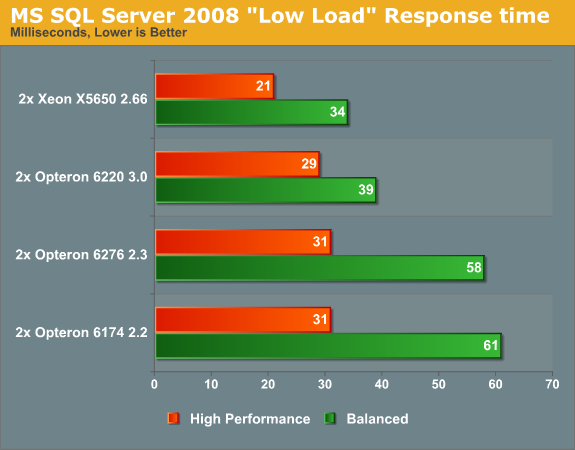The Opteron 6276: a closer look
by Johan De Gelas on February 9, 2012 6:00 AM EST- Posted in
- IT Computing
- CPUs
- Bulldozer
- AMD
- Opteron
- Cloud Computing
- Interlagos
MS SQL Server 2008 R2 at Low Load
Even in this virtualized age, lots and lots of servers are running close to idle quite a bit of time. We also checked how our servers behaved with 40 concurrent users.

The CPUs with the highest single threaded performance have the advantage with the balanced power management mode, but in this situation the power consumed is a lot more important:

The Opteron 6174 has no core gating and it shows: the power consumed is about 10 to 15% higher. The Xeon continues to lead in balanced mode, with clearly better response times and a small power advantage. At low load the Opteron 6220 does well, but the best Opteron remains the Opteron 6276. It offers comparable performance/watt to the Xeon in "High Performance mode" : slightly lower power consumption with slightly higher but still very respectable response times.










46 Comments
View All Comments
sonofgodfrey - Thursday, February 9, 2012 - link
Have you explicitly tested one socket vs. two sockets? We've found an immense increase in contention once a cache-line has to be shared between sockets on some systems.JohanAnandtech - Friday, February 10, 2012 - link
That is one suggestion I will try out next week. Thanks!Klimax - Thursday, February 9, 2012 - link
Hello.Nice tests.
However I would like to see MySQL tested on Windows Server 2008 R2
Would be interesting comparsion.
(Especially due to http://channel9.msdn.com/shows/Going+Deep/Arun-Kis... )
Klimax - Thursday, February 9, 2012 - link
Title of post is wrong... (I have deleted second thing and forgot to fix title)Scali - Thursday, February 9, 2012 - link
Unless I'm mistaken, the Xeon 5650 is a 1.17B transistor chip, where the Interlagos 6276 is a 2.4B transistor chip.In that light, doesn't that make Intel's SMT implementation a lot better than CMT?
I mean, yes CMT may give more of a performance boost when you increase the threadcount. But considering the fact that AMD spends more than twice the number of transistors on the chip... well, that's pretty obvious.
AMD might as well just have used conventional cores.
The true strength of SMT is not so much that it improves performance in multithreaded scenarios, but that it does so at virtually no extra cost in terms of transistors (and with little or no impact on the single-threaded performance either).
JohanAnandtech - Friday, February 10, 2012 - link
Interlagos is 1.2 billion chip (maybe 1.3 but anyway). Most of those transistors are spend on the L3 cache: about 0.5 billion. Only 213 million transistors are in a module and each module contains a 2 MB L2-cache, probably good for 120 million transistors. That leaves 90 million transistors to the core, and it has been stated that the second cluster added 12%. So that second cluster costs about 12 million transistors, or 48 million on the total 4 module die. That is less than 5% of the total transistor count but you get a 30-90% performance boost!So for AMD, this was clearly a great choice.
SMT is perfect for Intel, as the Intel architecture puts all instructions in one big ROB.
For very low IPC serverworkloads, I think the CMT approach gives better results. Unfortunately AMD lowered some of the CMT benefits by keeping the datacache so small and the low associativity of the Icache.
Scali - Friday, February 10, 2012 - link
Uhhh, I think you're wrong here... the 4-module Bulldozer is a 1.2B chip (Zambezi). But you tested the 8-module Interlagos (16 threads), which is TWO Zambezi dies in one package.Hence 2*1.2 = 2.4B transistors.
JohanAnandtech - Friday, February 10, 2012 - link
Ok, it is two chips of 1.2 billion. That doesn't change anything about our analyses of CMT.Scali - Friday, February 10, 2012 - link
Not in the article, because you did not factor in transistor count (which is the flaw I tried to point out in the first place... comparing two chips, where once is twice the transistor count of the other, is quite the apples-to-oranges comparison. One would expect a chip with twice the transistorcount to be considerably better in multithreading scenarios, not 'catching up' to the smaller chip).But in your above post, I think it changes everything about your analysis. All your figures have to be done times two.
Which makes it a very poor comparison, not only to Intel, but also to AMD's own previous line of CPUs.
The 6174 Magny Cours is actually beating Interlagos, with 'only' 12 threads, no kind of CMT/SMT, and 'only' 1.8B transistors.
How does that make CMT look like a great choice for AMD?
slycer.tech - Friday, February 10, 2012 - link
What i read on benchmark configuration page, Anand used 2x Intel Xeon X5650. So 2x 1.17B = 2.34B. I think it is comparable to AMD CPU used in this test. Am I right?